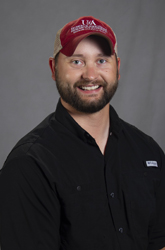
Thomas R. Butts is an Assistant Professor, Extension Weed Scientist with the University of Arkansas System Division of Agriculture based out of Lonoke, Arkansas. His research and Extension efforts focus on identifying novel weed management strategies through diversified approaches, including precision agriculture and application technologies in rice, soybean, corn, and wheat. Further emphasis is placed on helping to increase herbicide application knowledge, safety, and effectiveness, while reducing off-target movement. Tommy completed his Bachelor of Science in Agri-Business at the University of Wisconsin-Platteville and his Master of Science in Agronomy-Weed Science at the University of Wisconsin-Madison. He investigated the influence of integrated weed management strategies, including soybean row width, seeding rate, and herbicide program, on pigweed management across the Midwest and Mid-South. Additionally, he conducted herbicide resistance screenings on several pigweed species from Wisconsin, and reported the first confirmed incidences of glyphosate-resistant common waterhemp and Palmer amaranth within the state. Tommy then pursued his PhD in Agronomy-Weed Science from the University of Nebraska-Lincoln, specializing in spray equipment and application technologies. There, Tommy researched the influence of pulse-width modulation (PWM) on spray characteristics and sprayer performance. Additionally, he studied the influence of spray droplet size from PWM sprayers on herbicide efficacy and spray drift mitigation.
Thomas R. Butts is an Assistant Professor, Extension Weed Scientist with the University of Arkansas System Division of Agriculture based out of Lonoke, Arkansas. His research and Extension efforts focus on identifying novel weed management strategies through diversified approaches, including precision agriculture and application technologies in rice, soybean, corn, and wheat. Further emphasis is placed on helping to increase herbicide application knowledge, safety, and effectiveness, while reducing off-target movement. Tommy completed his Bachelor of Science in Agri-Business at the University of Wisconsin-Platteville and his Master of Science in Agronomy-Weed Science at the University of Wisconsin-Madison. He investigated the influence of integrated weed management strategies, including soybean row width, seeding rate, and herbicide program, on pigweed management across the Midwest and Mid-South. Additionally, he conducted herbicide resistance screenings on several pigweed species from Wisconsin, and reported the first confirmed incidences of glyphosate-resistant common waterhemp and Palmer amaranth within the state. Tommy then pursued his PhD in Agronomy-Weed Science from the University of Nebraska-Lincoln, specializing in spray equipment and application technologies. There, Tommy researched the influence of pulse-width modulation (PWM) on spray characteristics and sprayer performance. Additionally, he studied the influence of spray droplet size from PWM sprayers on herbicide efficacy and spray drift mitigation.
